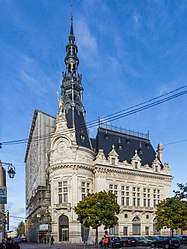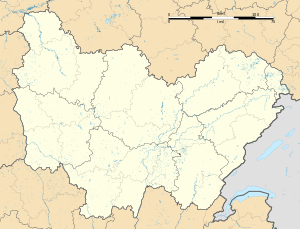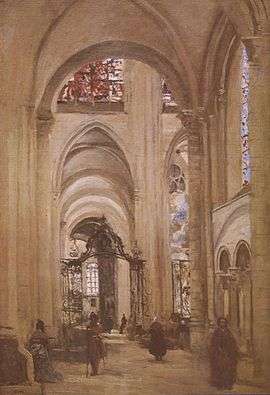Sens
| Sens | ||
|---|---|---|
| Subprefecture and commune | ||
 City Hall of Sens | ||
| ||
 Sens Location within Bourgogne-Franche-Comté region  Sens | ||
| Coordinates: 48°11′51″N 3°17′16″E / 48.1975°N 3.2877°ECoordinates: 48°11′51″N 3°17′16″E / 48.1975°N 3.2877°E | ||
| Country | France | |
| Region | Bourgogne-Franche-Comté | |
| Department | Yonne | |
| Arrondissement | Sens | |
| Canton | Sens-1 and 2 | |
| Government | ||
| • Mayor (2014–2019) | Marie-Louise Fort | |
| Area1 | 27.86 km2 (10.76 sq mi) | |
| Population (2006)2 | 26,646 | |
| • Density | 960/km2 (2,500/sq mi) | |
| Time zone | UTC+1 (CET) | |
| • Summer (DST) | UTC+2 (CEST) | |
| INSEE/Postal code | 89387 /89100 | |
|
1 French Land Register data, which excludes lakes, ponds, glaciers > 1 km2 (0.386 sq mi or 247 acres) and river estuaries. 2 Population without double counting: residents of multiple communes (e.g., students and military personnel) only counted once. | ||

Sens (French pronunciation: [sɑ̃s]) is a commune in the Yonne department in Bourgogne-Franche-Comté in north-central France, 120 km from Paris.
Sens is a sub-prefecture and the second city of the department, the sixth in the region. It is crossed by the Yonne and the Vanne, which empties into the Yonne here.
History
The city is said to have been one of the oppida of the Senones, one of the oldest Celtic tribes living in Gaul. It is mentioned as Agedincum by Julius Caesar[1] several times in his Commentarii de Bello Gallico. The Roman city was built during the first century BC and surrounded by walls during the third. It still retains today the skeleton of its Roman street plan.[2] The site was referred to by Ammianus Marcellinus as Senones (oppidum Senonas), where the future emperor Julian faced an Alamannic siege for a few months, but it did not become an administrative center until after the reorganization of the Roman Empire in 375, when it was the chief town of Lugdunensis Quarta.
During the Middle Ages its archbishops[3] held the prestigious role of primate of Gaul and Germany. The Hôtel de Sens in Paris was their official residence in that city. The Archdiocese of Sens ruled over the dioceses of Chartres, Auxerre, Meaux, Paris, Orléans, Nevers and Troyes, summarized by the acronym CAMPONT .
Starting from 1135, the cathedral of Sens, dedicated to Saint Stephen, was rebuilt as one of the first Gothic cathedrals. There, in 1234, Louis IX of France celebrated his wedding to Marguerite of Provence. Sens witnessed the trial of Peter Abelard. Pope Alexander III sojourned for some time in the city, and there also Thomas Becket spent part of his exile between 1162 and 1165. The Archdiocese of Sens hosted a number of church councils and the first Archbishop of Upsalla was consecrated there. William of Sens was the principal architect of Canterbury Cathedral.
Sens experienced troublesome times during the Wars of Religion.
The city declined after Paris was elevated to archdiocese in 1622. Since 2002 Sens remains an archbishopric (though the incumbent resides in Auxerre since 1929?) but with no metropolitical function (no pallium or marriage appeals).
Despite the creation of new regions, Sens remains subject to the Paris cour d'appel.
Main sights
- The Cathedral, one of the first Gothic edifices in France
- Archbishops' Palace
- Church of St. Maurice
- House of Abraham
- Museum
- Serres municipales de Sens, municipal greenhouses
Notable people
- Joseph ben Nathan Official, a French-Jewish controversialist. He lived, probably in Sens, in the thirteenth century.
- Samo, Frankish merchant and later king (rex) of the 7th century Slavic state known as Samo's Empire (Sens is one of two presumed birthplaces, the other being Soignies).
- Thomas Becket, Archbishop of Canterbury. In 1164, he took refuge in Sens, where Pope Alexander III was sheltered.
- Louis Jacques Thénard, French chemist, educated at the academy of Sens.
- Samson ben Abraham, 12th century rabbi and notable Tosafist.
- Jacques Almain (d. 1515), notable theologian at Collège de Navarre known for defending conciliarism, was born in Sens.
- Victor Scipion Charles Auguste de La Garde de Chambonas, mayor of Sens, brigadier general, and French foreign minister, at the beginning of the French Revolution.
- It is the presumed birthplace of the 12th-century architect William of Sens.
- Charles Levert (1825–1899), French public servant and politician
- Édouard Charton, an eminent French literary figure.
- Maurice Prou, historian.
- Saturnin Fabre, French film actor.
- Chris Malonga, footballer.
- Bacary Sagna, footballer.
- Clément Chantôme, footballer.
Twin towns
See also
Notes
- ↑ The manuscripts of the Gallic War also give varied readings of Agendicum and Agetincum (William Smith, ed. A Dictionary of Greek and Roman Geography); the gilded statue of "Brennus" ("leader") surmounts the hôtel de ville.
- ↑ Its Cardo (rue de la République) and Decumanus Maximus (Grande Rue) still meet at near right angles.
- ↑ The bishop of Sens perhaps became an archbishop as early as the mid-5th century, but the cult of the traditional founders Savinian and Potentian, not mentioned by Gregory of Tours, did not appear until the 8th century, when they were added to the local recension of the Seventy Apostles. (Catholic Encyclopedia: Sens).
References
External links
| Wikimedia Commons has media related to Sens. |


- Tourist Office (in English)
- Official website (in French)
- City council website (in French)
- Richard Stillwell, ed. Princeton Encyclopedia of Classical Sites, 1976: "Agedincum (Sens), Yonne, France"
